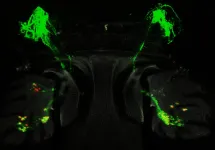(Press-News.org) (Vienna, March 17, 2021) When complex systems double in size, many of their parts do not. Characteristically, some aspects will grow by only about 80 percent, others by about 120 percent. The astonishing uniformity of these two growth rates is known as "scaling laws." Scaling laws are observed everywhere in the world, from biology to physical systems. They also apply to cities. Yet, while a multitude of examples show their presence, reasons for their emergence are still a matter of debate.
A new publication in the Journal of The Royal Society Interface now provides a simple explanation for urban scaling laws: Carlos Molinero and Stefan Thurner of the Complexity Science Hub Vienna (CSH) derive them from the geometry of a city.
Scaling laws in cities
An example of an urban scaling law is the number of gas stations: If a city with 20 gas stations doubles its population, the number of gas stations does not increase to 40, but only to 36. This growth rate of about 0.80 per doubling applies to much of the infrastructure of a city. For example, the energy consumption per person or the land coverage of a town rises by only 80 percent with each doubling. Since this growth is slower than what is expected from doubling, it is called sub-linear growth.
On the other hand, cities show more-than-doubling rates in more socially driven contexts. People in larger cities earn consistently more money for the same work, make more phone calls, and even walk faster than people in smaller towns. This super-linear growth rate is around 120 percent for every doubling.
Remarkably, these two growth rates, 0.8 and 1.2., are showing up over and over again in literally dozens of city-related contexts and applications. However, so far it is not really understood where these numbers come from.
It's all in the geometry
Stefan Thurner and former CSH researcher Carlos Molinero, who worked on this publication during his time in Vienna, now show that these scaling laws can be explained by the spatial geometry of cities. "Cities are always built in a way that infrastructure and people meet," says Molinero, an urban science expert. "We therefore think that scaling laws must somehow emerge from the interplay between the places people live in, and the spaces they use to move through a city -- basically its streets."
"The innovative finding of this paper is how the spatial dimensions of a city relate to each other," adds complexity researcher and physicist Stefan Thurner.
Fractal geometry
To come to this conclusion, the researchers first mapped three-dimensionally where people live. They used open data for the height of buildings in more than 4,700 cities in Europe. "We know most of the buildings in 3D, so we can estimate how many floors a building has and how many people live in it," says Thurner. The scientists assigned a dot to every person living in a building. Together, these dots form sort of a "human cloud" wthin a city.
Clouds are fractals. Fractals are self-similar, meaning that if you zoom in, their parts look very similar to the whole. Using the human cloud, the researchers were able to determine the fractal dimension of a city's population: They retrieved a number that describes the human cloud in every city. Similarly, they calculated the fractal dimension of cities' road networks.
"Although these two numbers vary widely from city to city, we discovered that the ratio between the two is a constant," Thurner says. The researchers identified this constant as the "sublinear scaling exponent."
Aside from the elegance of the explanation, the finding has potential practical value, as the scientists point out. "At first sight this looks like magic, but it makes perfect sense if one takes a closer look," Thurner says. "It's this scaling exponent that determines how the properties of a city change with its size, and that is relevant because many cities around the world are growing rapidly."
A formula for sustainable urban planning
The number of people living in cities worldwide is expected to roughly double in the next 50 to 80 years. "Scaling laws show us what this doubling means in terms of wages, crime, inventiveness or resources needed per person -- all this is important information for urban planners," Thurner points out.
To know the scaling exponent of a particular city could help urban planners to keep the gigantic resource demands of urban growth at bay. "We can now think specifically about how to get this number as small as possible, for example through clever architectural solutions and radically different approaches to mobility and infrastructure construction," Stefan Thurner is convinced. "The smaller the scaling exponent, the higher the resource efficiency of a city," he concludes.
INFORMATION:
Carlos Molinero, Stefan Thurner, "How the geometry of cities determines urban scaling laws," J of The Royal Society Interface, 17 March 2021
http://rsif.royalsocietypublishing.org/lookup/doi/10.1098/rsif.2020.0705
About the Complexity Science Hub Vienna (CSH):
The mission of CSH Vienna is to host, educate, and inspire complex systems scientists dedicated to making sense of Big Data to boost science and society. Scientists at the Hub develop methods for the scientific, quantitative, and predictive understanding of complex systems. Focal areas include the resilience and efficiency of socio-economic and ecological systems, network medicine, the dynamics of innovation, and the science of cities.
The Hub is a joint initiative of AIT Austrian Institute of Technology, Central European University CEU, Danube University Krems, Graz University of Technology, IIASA International Institute for Applied Systems Analysis, IMBA, Medical University of Vienna, TU Wien, VetMedUni Vienna, Vienna University of Economics and Business, and Austrian Economic Chambers (WKO).
http://www.csh.ac.at
The UK variant of SARS-CoV-2 spread rapidly in care homes in England in November and December last year, broadly reflecting its spread in the general population, according to a study by UCL researchers.
The study, published as a letter in the New England Journal of Medicine, looked at positive PCR tests of care home staff and residents between October and December. It found that, among the samples it had access to, the proportion of infections caused by the new variant rose from 12% in the week beginning 23 November to 60% of positive cases just two weeks later, in the week beginning 7 December.
In the south east of England, where the variant was most dominant, the proportion increased from 55% to 80% over the same period. In London, where the variant spread fastest, ...
Washington, DC, March 16, 2021 - A study in the Journal of the American Academy of Child and Adolescent Psychiatry (JAACAP), published by Elsevier, reports on the young adult assessment of the now 20-year longitudinal Boricua Youth Study (BYS), a large cohort that brings much needed insight about development and mental health of children from diverse ethnic background growing up in disadvantaged contexts.
The present article, with its companion report on prevalence of conditions and associated factors, provides an update on the study's fourth wave, which follows-up two probability-based population samples of children of Puerto Rican heritage. ...
Certain brightly colored coral species dotting the seafloor may appear indistinguishable to many divers and snorkelers, but Florida State University researchers have found that these genetically diverse marine invertebrates vary in their response to ocean warming, a finding that has implications for the long-term health of coral reefs.
The researchers used molecular genetics to differentiate among corals that look nearly identical and to understand which species best coped with thermal stress. Their research was published in the journal Ecology.
"Being able to recognize the differences among these coral species that cannot be identified in the field -- which are known as 'cryptic species' -- will help us understand new ways ...
The electron is one of the fundamental particles in nature we read about in school. Its behavior holds clues to new ways to store digital data.
In a study published in Nano Letters, physicists from Michigan Technological University explore alternative materials to improve capacity and shrink the size of digital data storage technologies. Ranjit Pati, professor of physics at Michigan Tech, led the study and explains the physics behind his team's new nanowire design.
"Thanks to a property called spin, electrons behave like tiny magnets," Pati said. "Similar to how a bar magnet's magnetization is dipolar, pointing from south to north, ...
The Volcano Alert Level (VAL) system, standardized by the United States Geological Survey (USGS) in 2006, is meant to save lives and keep citizens living in the shadow of an active volcano informed of their current level of risk.
A new study published in Risk Analysis suggests that, when an alert remains elevated at any level above "normal" due to a period of volcanic unrest, it can cause a decline in the region's housing prices and other economic indicators. Because of this, the authors argue that federal policymakers may need to account for the effects of prolonged volcanic unrest -- not just destructive eruptions -- in the provision of disaster relief funding.
A team of geoscientists and statistical experts examined the historical relationship ...
As researchers push the boundaries of battery design, seeking to pack ever greater amounts of power and energy into a given amount of space or weight, one of the more promising technologies being studied is lithium-ion batteries that use a solid electrolyte material between the two electrodes, rather than the typical liquid.
But such batteries have been plagued by a tendency for branch-like projections of metal called dendrites to form on one of the electrodes, eventually bridging the electrolyte and shorting out the battery cell. Now, researchers at MIT and elsewhere have found ...
Even though a fruit fly doesn't have ears, it can hear with its antennae. In a END ...
The first known study to explore optimal outpatient exam scheduling given the flexibility of inpatient exams has resulted in shorter wait times for magnetic resonance imaging (MRI) patients at END ...
FINDINGS
A new UCLA study shows that while men and women who have high muscle mass are less likely to die from heart disease, it also appears that women who have higher levels of body fat -- regardless of their muscle mass -- have a greater degree of protection than women with less fat.
The researchers analyzed national health survey data collected over a 15-year period and found that heart disease-related death in women with high muscle mass and high body fat was 42% lower than in a comparison group of women with low muscle mass and low body fat. However, women who had high muscle mass and low ...
A global review of coastal drowning science has found there is only one study worldwide that has evaluated beach safety education programs in schools.
Researchers from UNSW's Beach Safety Research Group have conducted the first in-depth review specific to coastal drowning.
The study, published in PLOS ONE, reviewed 146 coastal drowning studies from around the world.
"We found that evaluation of coastal drowning prevention strategies is rare," said William Koon, the lead author of the study and a PhD candidate in the School of Biological, Earth ...


